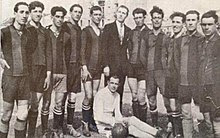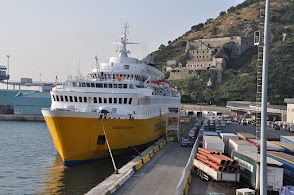Tiny club from Liguria emerged the winners
The first final of the Coppa Italia, which was to become Italian football’s equivalent of England’s celebrated FA Cup knock-out competition, took place on this day in 1922.
The 11 players and their manager, centre, who
gave Vado their moment in the spotlight
It was won by Vado Foot-Ball Club, from Vado Ligure, a commercial and industrial port in the province of Savona in Liguria.
Vado, who defeated Udinese in the final to lift the trophy, have not won any major honours in 101 years since their famous triumph and currently play in Serie D, the fourth tier in the Italian football pyramid.
The circumstances of their victory would look quite bizarre in the context of modern-day football.
The competition itself existed only because of a major schism in the Italian championship that had taken place the year before, when 24 of the country’s major clubs broke away from the Italian Football Federation (FIGC) to form their own championship after a demand for a reduction in the number of teams in the Prima Categoria - the forerunner of Serie A - was rejected.
With the likes of Pro Vercelli, Juventus, Bologna and AC Milan choosing to play in the new Italian Football Championship (CCI), the FIGC launched the Coppa Italia as an attempt to regain prestige.
.jpg) |
| Felice Levratto, who scored the winning goal in the final, went on to play for Italy |
The invitation was thus extended to teams from the second-tier Promozione division, which included Vado. The total entry grew to 37 teams.
The structure of the new tournament was further complicated by the rules for taking part. Participating teams, which had to be able to provide a fenced playing area, had to guarantee to pay the FIGC a sum of 100 lire to host a match, in addition to paying the opposition players (and their manager) a fee of 30 lire each, plus the cost of third-class rail travel to and from the tie.
Clubs drawn at home but unable to meet those requirements had the option to switch to the home ground of their opponents.
While other clubs baulked, Vado took advantage of this rule. Through the entrepreneurial skills of their managers, they were able to raise the funds to offer to pay the costs of every team against which they were drawn and play five of their six ties at their home ground - the Campo di Leo - including the final itself.
Vado almost left the competition in the first round, needing extra time to overcome Fiorente Genova 4-3. Wins against Molassano (5-1) and Juventus Italia Milano (2-0) followed, before their only away tie, against a strong Pro Livorno team, in which they came out on top by a single goal.
The semi-final turned out to be another tough battle, against Libertas Firenze - the future Fiorentina - which Vado won in extra time.
 |
| The replica of the Coppa Italia trophy won by Vado in 1922 |
Yet Vado again had the advantage of playing at home and prevailed - again in extra time - thanks to star player Felice Levratto’s goal.
Levratto went on to enjoy a successful career with Genoa, Ambrosiana-Inter and Lazio, as well as playing for the Italian national team at the 1928 Olympics in Amsterdam.
The Coppa Italia did not become a regular fixture in the Italian football calendar until 1935, by which time the breakaway by the top clubs had long been resolved and Vado were a lower-tier club unlikely to climb much higher than the occasional foray into Serie C.
The trophy they were awarded in 1922, meanwhile, no longer existed, having been handed by the club as a gift to the nation on Fascist dictator Benito Mussolini’s so-called ‘day of faith’ in December 1935, to be melted down along with tens of thousands of gold and silver rings donated by Italian women as a means of raising funds for Mussolini's empire-building ambitions.
However, the fact of Vado’s victory could never be taken away and in 1992, following a friendly against Udinese to mark the anniversary, the FIGC presented FC Vado, as the club is now known, with an exact replica of the original trophy.
That trophy was placed in a case on display inside the Vado Ligure branch of the Cassa di Risparmio di Savona bank in Piazza Cavour, where it remains.
The port of Vado Ligure, just outside the city of Savona, has its roots in the Roman era, when it was called Vada Sabatia. A former military camp, it was one of the first Roman settlements in Liguria, becoming an important traffic hub for trade. Now heavily industrialised, it is home to a large railway construction plant, founded in 1905 as Società Italiana Westinghouse and now part of Bombardier Transportation. Vado also has an electric power plant, whose two towers, 200 metres (660 ft) high, are visible from many kilometres away. In the centre of the town, there are some attractive pedestrianised areas, while the beach front has many bars and restaurants.
Travel tip:
The beautiful Piazza della Libertà is Udine's
main square and architectural showpiece
Udine, whose Udinese team provided the opposition when FC Vado Ligure won the Coppa Italia, is an attractive and wealthy provincial city and the gastronomic capital of Friuli-Venezia Giulia. Udine's most attractive area lies within the mediaeval centre, which has Venetian, Greek and Roman influences. The main square, Piazza della Libertà, features the town hall, the Loggia del Lionello, built in 1448–1457 in the Venetian-Gothic style, and a clock tower, the Torre dell’Orologio, which is similar to the clock tower in Piazza San Marco - St Mark's Square - in Venice. The city was part of the Austrian Empire between 1797 and 1866 and retains elements of a café society as legacy from that era, particularly around Piazza Matteotti.
Also on this day:
1194: The birth of St Clare of Assisi
1486: The birth of painter Andrea del Sarto
1852: The birth of sculptor Vincenzo Gemito

No comments:
Post a Comment